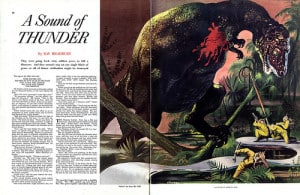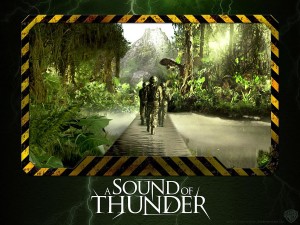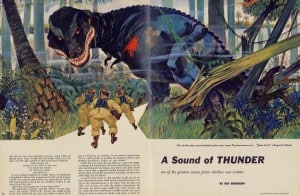 I like time travel movies, though not the kind in which characters hang out in the past, wear ‘funny’ clothes or commune with either their parents or dudes named So-crates. I see film as essentially a kind of time travel experiment: it interests me for the way we can mess with time in the movies, slowing it down, compressing it, creating parallel worlds, and literally rerunning time to see how history unfolds in various ways. That last scenario beguiles historians–how can we determine what is most important in the past in order to explain significance to the present? And as Andrew suggested in his recent post, science fiction often offers a way to bring film to bear on contemporary politics without necessarily sounding pedantic or polemical. And like him, I am happy to participate in the For the Love of Film Blogathon which focuses on science fiction this year by contributing an essay on my peculiar interest. Please consider helping to support the preservation of films–a national treasure–by donating here.
I like time travel movies, though not the kind in which characters hang out in the past, wear ‘funny’ clothes or commune with either their parents or dudes named So-crates. I see film as essentially a kind of time travel experiment: it interests me for the way we can mess with time in the movies, slowing it down, compressing it, creating parallel worlds, and literally rerunning time to see how history unfolds in various ways. That last scenario beguiles historians–how can we determine what is most important in the past in order to explain significance to the present? And as Andrew suggested in his recent post, science fiction often offers a way to bring film to bear on contemporary politics without necessarily sounding pedantic or polemical. And like him, I am happy to participate in the For the Love of Film Blogathon which focuses on science fiction this year by contributing an essay on my peculiar interest. Please consider helping to support the preservation of films–a national treasure–by donating here.
 A time travel movie that plays in the past, present and future is A Sound of Thunder, a 2005 studio release starring Ben Kingsley, Edward Burns, and Catherine McCormack. The film did not do well. Reviews were, on balance, pretty awful. And it is safe to say that three leads are happy that they are remembered for other films. Yet, A Sound of Thunder had ambitions to do more and in a few specific ways it succeeded. First, it is based on the Ray Bradbury short story by the same name; second, it plays with the pulpiness of Bradbury’s story and the time in which it originally appeared, the early 1950s, with its kitchy cinematography, set design, and dialogue; and third, it riffs on the famous “butterfly effect.”
A time travel movie that plays in the past, present and future is A Sound of Thunder, a 2005 studio release starring Ben Kingsley, Edward Burns, and Catherine McCormack. The film did not do well. Reviews were, on balance, pretty awful. And it is safe to say that three leads are happy that they are remembered for other films. Yet, A Sound of Thunder had ambitions to do more and in a few specific ways it succeeded. First, it is based on the Ray Bradbury short story by the same name; second, it plays with the pulpiness of Bradbury’s story and the time in which it originally appeared, the early 1950s, with its kitchy cinematography, set design, and dialogue; and third, it riffs on the famous “butterfly effect.”
The action in the movie revolves around a time travel company called Time Safari, Inc. that promises to bring people from the year 2055 back to the age of dinosaurs to hunt a T-Rex. The target of the hunt will die either way during the five minutes that the hunting party returns to this misty past–the killer lizard gets hit by a huge tree–and so the future is not in danger of changing because of this intervention. But on one hunt, a loudmouth wealthy financier freaks out at the sight of the T-Rex and fails to take a shot at the beast but does manage to kill a butterfly when he steps off a proscribed path. That single action unleashes what in the film are called “time waves.” This plot line diverges from Bradbury’s original story in order to create three dramatic changes in the present that lead to a war between humans and the creatures who evolve because that single butterfly got crushed by some jackass’s boot. As one might expect, the film resolves this disastrous situation with some truly bizarre time travel involving an intervention during which Edward Burns’s character almost runs into himself trying to correct the mission that created the catastrophic future.
But here’s the ambitious part: the film wanted to animate and make accessible that catchy but often misunderstood principle of the “butterfly effect.” A
Sound of Thunder followed in its date of release a film actually called The Butterfly Effect that starred the misguided Ashton Kutcher and was also inspired by Bradbury’s story. The funny thing is, of course, Bradbury is not typically credited with coining the term, Edward Lorenz is. Lorenz, as many of you know, was the famous MIT meteorologist who developed a model in 1961 to simulate the weather. As the story goes, one day he decided to change how he represented just one piece of data, rounding .506127 to .506, and by taking this one action he dramatically changed the long-term output of his model. He made this discovery famous in a 1972 paper entitled, “Predictability: Does the Flap of a Butterfly’s Wings in Brazil Set Off a Tornado in Texas?” We have lived with Lorenz’s evocative metaphor ever since.
Yet as science writer Peter Dizikes wrote in the Boston Globe in 2008, the butterfly effect does NOT suggest that any small event can lead to catastrophic or necessarily even measurable (perceptible) results. Dizikes explained:
Lorenz claimed the large effects of tiny atmospheric events pose both a practical problem, by limiting long-term weather forecasts, and a philosophical one, by preventing us from isolating specific causes of later conditions. The ‘innumerable’ interconnections of nature, Lorenz noted, mean a butterfly’s flap could cause a tornado–or, for all we know, could prevent one. Similarly, should we make even a tiny alteration to nature, ‘we shall never know what would have happened if we had not disturbed it,’ since subsequent changes are too complex and entangled to restore a previous state.
And so A Sound of Thunder and The Butterfly Effect both get the science wrong by offering a bizarre and unqualified understanding of how “sensitive dependence on initial conditions” actually works. But both movies also get Ray Bradbury’s science fiction wrong.
 As Jon Eller (Director of the Center for Ray Bradbury Studies
As Jon Eller (Director of the Center for Ray Bradbury Studies
) has argued in his work, the science fiction of Bradbury was literature because it reacted philosophically and politically to its times. In Bradbury’s original story, there are two main characters, Travis, the lead hunter for Time Safari and Eckles, the wealthy customer who goes on an ill-fated hunt. The short story unfolds as I described above, the hunt goes off, the T-Rex is killed, and Eckles, scared out of his wits, runs away and inadvertently steps on a butterfly. Early in the narrative, Bradbury introduces the “butterfly effect” (though he doesn’t call it that) with a good measure of ambiguity about what that effect actually might be:
A little error here would multiply in sixty million years, all out of proportion. Of course maybe our theory is wrong. Maybe Time can’t be changed by us. Or maybe it can be changed only in little subtle ways. A dead mouse here makes an insect imbalance there, a population disproportion later, a bad harvest further on, a depression, mass starvation, and finally, a change in social temperament in far-flung countries. Something much more subtle, like that. Perhaps only a soft breath, a whisper, a hair, pollen on the air, such a slight, slight change that unless you looked close you wouldn’t see it. Who knows? Who really can say he knows? We don’t know. We’re guessing. But until we do know for certain whether our messing around in Time can make a big roar or a little rustle in history, we’re being careful.
Upon returning to 2055, Eckles is thoroughly chastened by Travis but even more unsettled by a slight change in the present. Things are basically the same except they are not–Bradbury sets up his point by introducing early in the story a seemingly inconsequential conversation between Eckles and an office assistant about a recent presidential election. They both agree that the best man won and that the defeated candidate took political stands that should cause freedom-loving voters some dismay. However, when Eckles returns from the now changed past–because he killed a butterfly–the same office assistant is there, but now he is happy to report that the other candidate, “an iron man with guts” won the election–fascism reigns.
Of course, Bradbury doesn’t try to explain how killing a butterfly 65 million years earlier led to fascism in 2055, but those years did not concern Bradbury, 1952 did. Bradbury wrote this story in 1952. It appeared in Colliers that year and came out in a collection of short stories a year later. Bradbury did not vote for the military man with the distinguished war record in 1952 or 1956 and this story echoed the grave concerns he had about anti-communism and especially the tactics of Joseph McCarthy. Bradbury voiced these concerns in 1953 in an essay published in the Nation and later on in what is remains his most famous work, Fahrenheit 451.
The point that Bradbury made and I think the movies miss is not the fact that small events have major consequences but that all events, decisions, and actions come with responsibility–that we have responsibility for our actions and our lack of actions and that forces like McCarthy rise both because of what has happened in the past and, just as likely, what has not.

2 Thoughts on this Post
S-USIH Comment Policy
We ask that those who participate in the discussions generated in the Comments section do so with the same decorum as they would in any other academic setting or context. Since the USIH bloggers write under our real names, we would prefer that our commenters also identify themselves by their real name. As our primary goal is to stimulate and engage in fruitful and productive discussion, ad hominem attacks (personal or professional), unnecessary insults, and/or mean-spiritedness have no place in the USIH Blog’s Comments section. Therefore, we reserve the right to remove any comments that contain any of the above and/or are not intended to further the discussion of the topic of the post. We welcome suggestions for corrections to any of our posts. As the official blog of the Society of US Intellectual History, we hope to foster a diverse community of scholars and readers who engage with one another in discussions of US intellectual history, broadly understood.
I haven’t seen the movies but reading the story when I was a kid thoroughly freaked me out. The subtle change over time was better than the massive ones in the movies. Good essay.
Excellent article! I watched the movie a few years after reading the novel; recognised the general similarities, and welcomed the changes I suppose are necessary for the big screen. One of these was the “time ripples” as events in the past propagated forwards in time to the future. At first I thought it was quite clever, but then I had second thoughts. If you’re interested, I wrote a little about it in the link if you click on my name